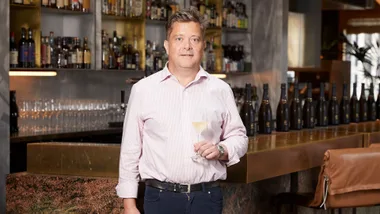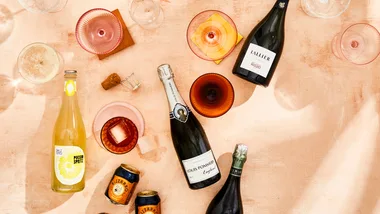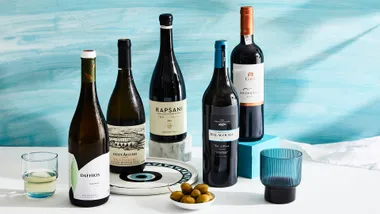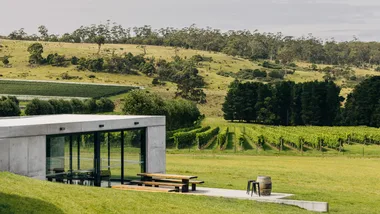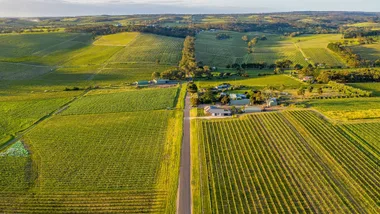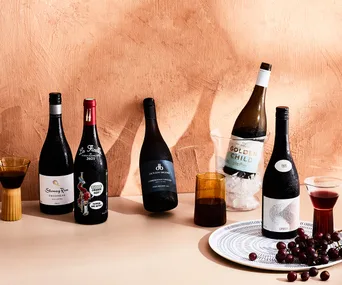Types of sparkling wine
Champagne
Not just any sparkling drop can call itself Champagne – that’s a label afforded only to the product of specific grapes (chardonnay, pinot noir and pinot meunier) as produced in the Champagne region of Northern France, and is regulated by Comité Interprofessionnel du vin de Champagne (CIVC). Champagne must be fermented twice in a process known as ‘methode champenoise’ or ‘methode traditionelle’ and left to sit for 18 months to three years before it is ready for sale.
‘Methode traditionelle’ sparkling
Many vignerons in regions outside of France, such as Tasmania, South Australia and southern New Zealand, are now producing high-quality sparklings to meet consumer demand in spite of the limited scope of Champagne production. Many, including South Australian Croser, use the same grape varieties and ‘methode traditionelle’ of fermentation to produce an array of exciting and inventive non-Champagne sparkling wines.
Prosecco
Prosecco is the name given to both a grape (more commonly known as ‘glera’) and a wine native to Veneto in North-Eastern Italy, which encapsulates the Adriatic city of Venice and stretches to the Dolomites some 3000 metres above sea level. Prosecco is not always sparkling, it can be still or semi-sparkling. Often served as an aperitif (or in a Bellini) it traditionally has a fruiter bouquet than Champagne, perhaps with notes of apple and pear.
Rosé
Much like a prosecco, rosé need not be sparkling, though bubbly variations are becoming increasingly popular in the market. The grape flesh used for rosé begins as does any other, in that it is opaque or pale in colour; its soft pink hue manufactured by either combining it with a finished pinot noir, or by leaving the grape’s flesh in contact with a dark skin.
Cava
A Spanish wine, cava is based on macabeo, parellada and xarel-lo grapes, and much like Champagne is fermented using the ‘methode traditionelle’. Cava manifests as either a white or rosé.
Vintage vs. non-vintage
A vintage is derived from the grapes of a single year, an instance of exceptional harvest which only occurs a handful of times per decade, which means vintages are generally rarer and more expensive. A non-vintage will blend multiple years’ harvests, which results in a more consistent drop than a vintage. Vintages tend to have a distinctive taste profile due to the singular harvest used.
Storage
Sparkling wine should be stored between 10 degrees and 13 degrees, but can be stored up to 20 degrees if the temperature is consistent. Be mindful that extended storage at a higher temperature will expedite the maturation of your drop, and as such is only recommended for younger vintages. It’s best to enjoy non-vintage Champagne and other sparkling wines soon after purchase, as they will have been pre-matured by their producer. Sparkling wine, as with any corked wine, should be stored on its side, or else you risk oxidation as the cork dries and shrinks.
Serving
Plan ahead, submerging your sparkling of choice in an ice bucket for 15-20 minutes directly before enjoying, don’t make the error of hastily chilling it in the freezer. To open sans spillage, hold the bottle at a 45 degree angle with a thumb firmly on the cork, and twist the bottle from underneath. The glass should also be held at a 45-degree angle during pour to avoid excessive bubbling.
As for the vessel? While a vintage coupe may be fit for Versailles, the frothy bubbles in your pour will dissipate more quickly than if in a long, tall flute. Hold the glass by the stem during sips to avoid inadvertently warming its contents.
Flavour
The three main grapes used in the production of Champagne, and commonly used in non-Champagne sparkling wines are: chardonnay, which lends a crisp taste; pinot noir, which offers berry notes; and pinot meunier, which is characteristically rich and earthy. ‘Blanc de blancs’ are made purely from light chardonnay grapes, while ‘blanc de noirs’ are made from the darker pinot noir or pinot meunier grapes (or both). Blanc de noirs tend to be more yellow in tone than chardonnay-derived blanc de blancs.
The sweetness of sparkling wine is exacted during its final fermentation cycle, and will sit anywhere on a scope of doux (the sweetest), demi-sec, extra sec, brut, through to extra brut (the driest). A matured drop will be toasty, nutty and/or smoky to the taste, gleaned from its oak barrels during ageing.
Tasting
Many conventional food and wine pairings are based on tangible elements such as colour and density-largely why white wines are often paired with white fish, full-bodied reds matched with a cut of red meat, and sparkling roses matched with sweets desserts or cheeses-but are more about a ‘feeling’ and don’t necessarily have weight taste-wise.
Many sparkling wines, including Champagne, will already have a robust flavour profile, so it’s wise to ground your tasting experience with either seafood, or earthy, gamey meats such as beef, lamb, duck, and venison. Charcoal-grilled foods pair well with oaky, matured sparkling wines and non-vintages. Include a cheddar or parmesan if enjoying with a cheese board. A sparkling wine will allow you to experiment with fatty and/or oily dishes, as the acidity in the sip will balance your palate anew. Incorporate spices and chillies in moderation, though if you’re compelled, opt for a sweeter wine, ideally a demi sec.
*
*
This article is presented by Croser Vintage

